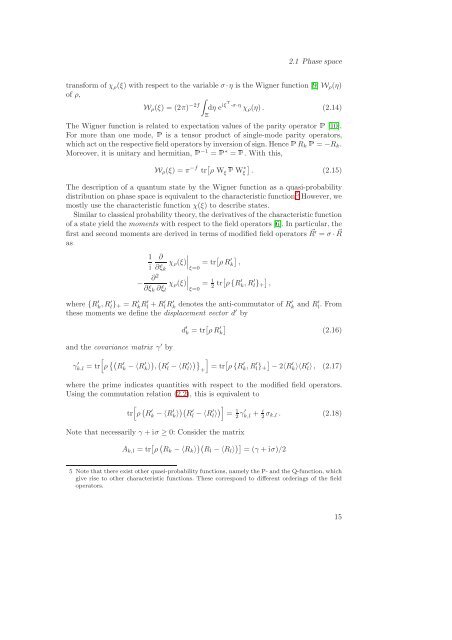Quantum Information Theory with Gaussian Systems
Quantum Information Theory with Gaussian Systems
Quantum Information Theory with Gaussian Systems
Create successful ePaper yourself
Turn your PDF publications into a flip-book with our unique Google optimized e-Paper software.
2.1 Phase space<br />
transform of χρ(ξ) <strong>with</strong> respect to the variable σ ·η is the Wigner function [9] Wρ(η)<br />
of ρ,<br />
Wρ(ξ) = (2π) −2f<br />
<br />
dη e<br />
Ξ<br />
iξT ·σ·η<br />
χρ(η). (2.14)<br />
The Wigner function is related to expectation values of the parity operatorÈ[10].<br />
For more than one mode,Èis a tensor product of single-mode parity operators,<br />
which act on the respective field operators by inversion of sign. HenceÈRkÈ=−Rk.<br />
Moreover, it is unitary and hermitian,È−1 =È∗ =È. With this,<br />
Wρ(ξ) = π −f tr ρ WξÈW ∗ ξ . (2.15)<br />
The description of a quantum state by the Wigner function as a quasi-probability<br />
distribution on phase space is equivalent to the characteristic function. 5 However, we<br />
mostly use the characteristic function χ(ξ) to describe states.<br />
Similar to classical probability theory, the derivatives of the characteristic function<br />
of a state yield the moments <strong>with</strong> respect to the field operators [6]. In particular, the<br />
first and second moments are derived in terms of modified field operators R ′ = σ · R<br />
as<br />
1 ∂<br />
<br />
<br />
χρ(ξ) = tr<br />
i ∂ξk ξ=0 ρ R ′ <br />
k ,<br />
− ∂2<br />
<br />
<br />
χρ(ξ) =<br />
∂ξk ∂ξl ξ=0 1<br />
2 trρ {R ′ k, R ′ <br />
l}+ ,<br />
where {R ′ k , R′ l }+ = R ′ kR′ l + R′ lR′ k denotes the anti-commutator of R′ k and R′ l . From<br />
these moments we define the displacement vector d ′ by<br />
and the covariance matrix γ ′ by<br />
γ ′ <br />
k,l = tr ρ R ′ k − 〈R ′ k〉 , R ′ l − 〈R ′ l〉 <br />
d ′ k = trρ R ′ <br />
k<br />
+<br />
<br />
(2.16)<br />
= tr ρ {R ′ k, R ′ ′<br />
l}+ − 2〈R k〉〈R ′ l〉, (2.17)<br />
where the prime indicates quantities <strong>with</strong> respect to the modified field operators.<br />
Using the commutation relation (2.2), this is equivalent to<br />
<br />
tr ρ R ′ k − 〈R ′ k〉 R ′ l − 〈R ′ l〉 <br />
= 1<br />
2 γ′ k,l + i<br />
2 σk,l . (2.18)<br />
Note that necessarily γ + iσ ≥ 0: Consider the matrix<br />
Ak,l = tr ρ Rk − 〈Rk〉 Rl − 〈Rl〉 = (γ + iσ)/2<br />
5 Note that there exist other quasi-probability functions, namely the P- and the Q-function, which<br />
give rise to other characteristic functions. These correspond to different orderings of the field<br />
operators.<br />
15
















